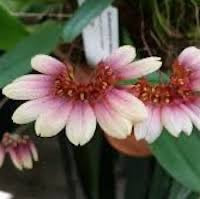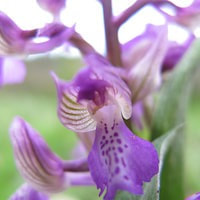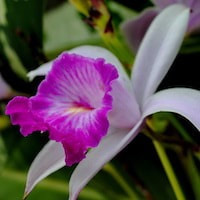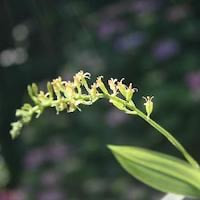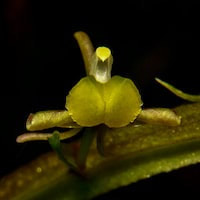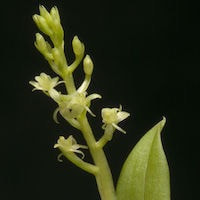MWD11- Men's Woody 11 - Ginger Happy
|
Native Singaporean Orchid notes: Rhyncattleanthe
Rhyncattleanthe, a hybrid orchid resulting from crossing Rth Hope Island 'Fantasy' with Rsc Erin Kobayashi 'Lahaina Gold' within the Cattleya alliance, boasts large, fragrant flowers. This hybrid is recognized for its vibrant yellow and lavender color combination, ensuring striking blooms of excellent size and shape. Orchids like Rhyncattleanthe are prized in perfume workshops for their aromatic oils, which contribute unique scents to custom fragrances. Proper care is crucial to nurture these delicate plants for optimal growth and bloom quality, enhancing the workshop's experience through their distinctive floral contributions.
|
Therapeutic Orchid notes:
|
Bulbophyllum flabellum-veneris Syn. Bulbophyllum lepidum (Blume) J.J. Sm., Cirrhopetalum lepidum (Blume) Schltr.
Bulbophyllum flabellum-veneris, also known as Bulbophyllum lepidum or Cirrhopetalum lepidum, is an orchid found across Southeast Asia, including Borneo, known for its olive-green flowers that bloom year-round, peaking during monsoon seasons. In traditional Thai medicine, various parts of the plant are used medicinally. The pseudobulb is particularly prized for treating oedema, the buildup of fluid causing swelling. The whole plant is also employed to support liver function, crucial for detoxification and metabolism. Scientific research on its medicinal properties is limited, highlighting the need for further studies to understand its effectiveness and safety in traditional healing practices. |
|
Anacamptis morio ssp. picta
Anacamptis morio ssp. picta, a subspecies of the Green-winged Orchid, grows in Iran and parts of Europe. Its tubers are harvested in Iran for salep, a traditional health drink considered a superfood for its nutritional richness. Salep is made by drying and grinding orchid tubers into a powder, mixed with milk or water to create a thick beverage. Due to overharvesting affecting orchid populations, Anacamptis species are protected in Europe, emphasizing the need for sustainable practices to preserve these plants for their ecological importance and cultural uses. |
|
Arundina graminifolia - It was one of 3 orchid that reappear in Krakatoa after the massive volcanic eruption in 1883 .
Arundina graminifolia, known as the Bamboo Orchid, is a terrestrial orchid widespread across Southeast Asia, named differently in various regions. It blooms olive-green flowers year-round, with flowering times varying across its range. Medicinally, it has diverse uses: in India, stem scrapings treat skin cracks, while in Hong Kong, the plant aids conditions like hepatitis, jaundice, and snakebites. Chemical analysis reveals compounds like stilbenoids and triterpenoids, contributing to its medicinal efficacy, including antitumor and antiviral activities observed in laboratory studies. Sustainable harvesting is critical to conserve this orchid and its medicinal potential. |
|
Liparis nakaharae Hayata
Liparis nakaharae, also known as Aochunyangersuan in Chinese, is a native orchid species in Taiwan believed to have medicinal properties according to Taiwanese folk medicine, where it is used to treat cancer. However, it's crucial to understand that using Liparis nakaharae or any herbal remedy for cancer should not replace conventional medical treatments like surgery, chemotherapy, or radiation. Scientific evidence supporting orchid-based treatments for cancer is lacking, so it's important for cancer patients to consult healthcare professionals for appropriate and evidence-based treatment plans tailored to their individual needs and conditions. |
|
Liparis rheedii Lindl.
Liparis rheedii, known as Simil in India, is a terrestrial orchid with closely clustered pseudobulbs. The plant's color, ranging from deep purple in shade to pure green in light, varies based on its light exposure. Found in mountain forests across southern India, Thailand, and Southeast Asia, Liparis rheedii is used traditionally as a tonic in Karnataka, India, and is an ingredient in the Ayurvedic medicine Ashtavarga. Hill tribes in Orissa utilize its root to treat cholera, prepared by boiling 250 grams in water until reduced and mixing with honey for oral consumption. Caution and medical guidance are advised when using traditional herbal remedies like Liparis rheedii, as their safety and effectiveness may not be scientifically validated. |
|
Liparis stricklandiana Rchb. f.
Liparis stricklandiana, known as Shanchunyangersuan or Luhuayangersuan in Chinese, is an epiphytic orchid found in forests on hill slopes across regions like Hong Kong, Guangdong, Yunnan in China, and Tibet, Vietnam, Sikkim, Bhutan, and Nepal. In traditional herbal medicine, it is utilized for treating sores, abscesses, and ulcers, suggesting potential wound-healing or anti-inflammatory properties. However, scientific evidence supporting these medicinal uses remains limited, highlighting the importance of caution and further research in validating its traditional therapeutic benefits. |
Other scent note
Scentopia Library Reference ingredient
Sandalwood- Check details at Scentopia's scent library
Download the guided mediation that works best with this Orchid fragrance oil
| men_woody_essential_oil_orchi_00011.mp3 | |
| File Size: | 115667 kb |
| File Type: | mp3 |

